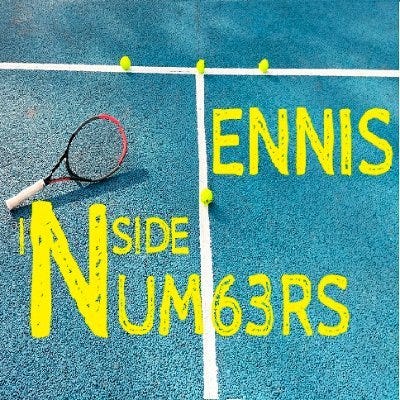Coco Gauff is a multiple Major champion!
The 21-year old American added a Coupe Suzan-Lenglen to her trophy collection with a 6-7 [5:7], 6-2, 6-4 triumph over Aryna Sabalenka in a French Open final that brought back memories of the 2023 US Open title decider.
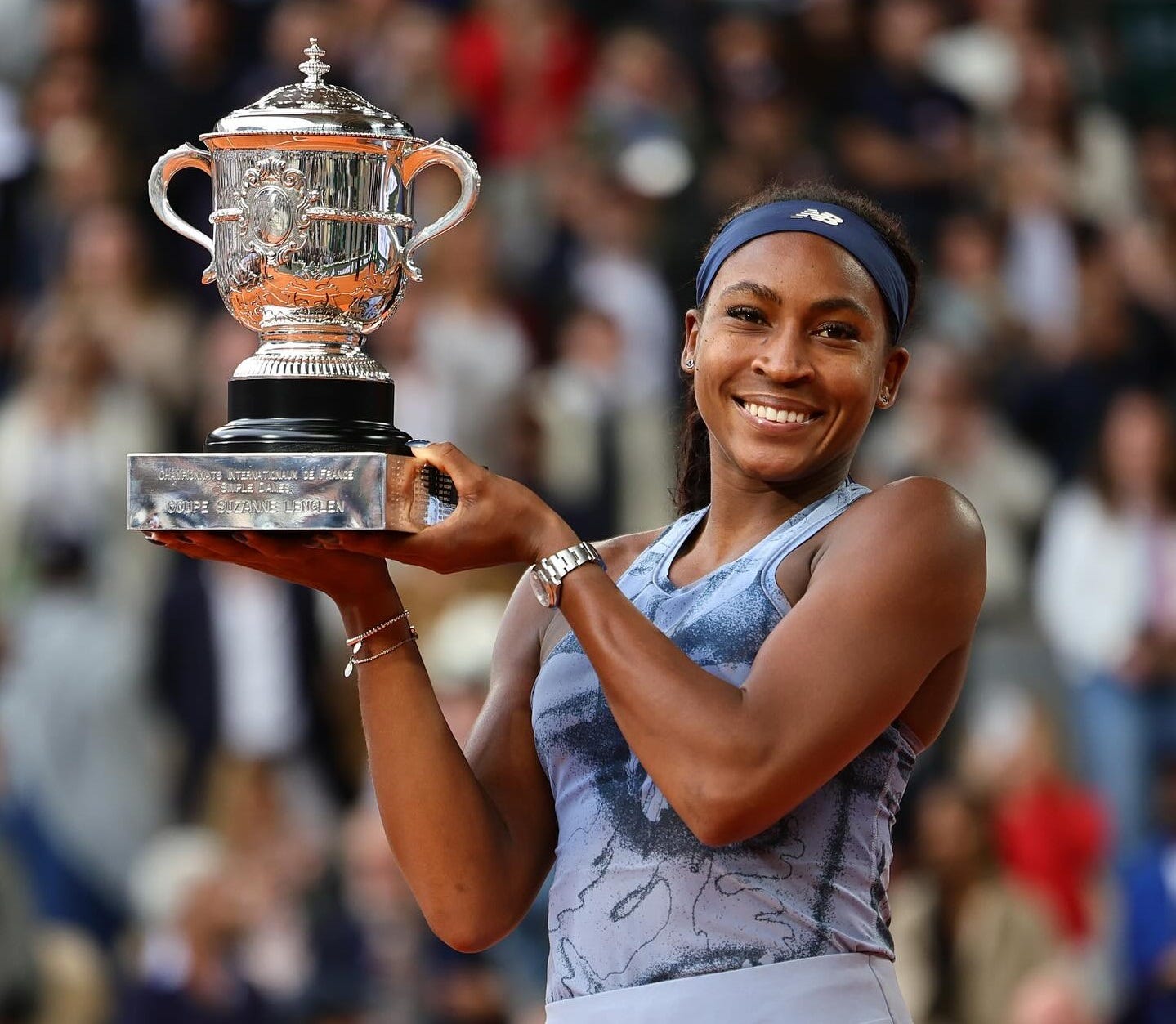
Just like in New York, Gauff recovered from a set down by clamping down on unforced errors, driving average rally length up, hitting with spin and margin to counter windy conditions and leaning on agility, speed, athleticism and anticipation to play great defense and make one more ball… and one more ball. A formula that wore down Sabalenka, grew her frustration and led the world #1 to chose the wrong shot or go bigger than recommended.
While most of the post-match talk highlighted Sabalenka’s record-setting amount of unforced errors in a Grand Slam final — 67 by our account, 70 on the official scoresheet — credit must be given to Gauff’s singular ability to unforce opponents.
A power that Andrea Petkovic described brilliantly in her latest piece:
“The unforced errors hit by Coco’s opponents when she’s playing well are actually forced. Except, they are not forced by Coco’s previous shot (which is what usually goes into the forced error statistics) but they are forced by the entirety of her game and presence on the other side of the net and by choices she has made 20 minutes prior to the point of you netting a forehand.
The panic on Sabalenka’s face was caused by stress and stress is the body’s response to a challenging situation your system is not sure it can overcome. The smaller the court on the other side got, the higher the stress levels felt for Aryna. The match point was a summary of the match. Aryna missed a backhand wide, aiming for the ultimate precision in tennis: The line. The moment you start aiming for lines, time has already been up 10 minutes ago. And that’s how Coco wins matches and titles and trophies. First she steals your space, then she steals your time.”
Match analysis
The 2025 French Open final began with Sabalenka actually looking like she could win it in no time. As the world #1 raced to a 4-1 40/0 lead — a double break up — in 20 minutes, we recalled her massive 17-point streak at about the same stage of the recent Madrid final against Gauff that stamped her authority and led to a straight-sets win or her third set demolition of Iga Swiatek in the Roland Garros top-half semifinal.
Doing little wrong off the blocks, the Belarusian won 23 of the first 33 points played and went a perfect 5-for-5 when attempting a drop shot. A strong start that contrasted with Gauff’s struggles to keep the ball in play, translated into 11 early unforced errors.
Set 1, part 1 (up to Sabalenka’s 4-1 40/0 lead)
Sabalenka: 5 winners / 5 unforced errors = 0
Gauff: 2 winners / 11 unforced errors = -9
But as Sabalenka stood on the verge of a commanding 5-1 lead, she threw Gauff a lifeline by squandering 2 of her game points with double faults*.
* If anyone said before the match that double faults would be a factor, the immediate reaction was to name Gauff as the one in trouble. Even though the American did finish with 2 more double faults (8 to 6), Sabalenka’s were more harmful:
played a huge role in halting her initial momentum during the match-altering 6th game
wasted a set point at 5-4 in the first set
surrendered the first break of the deciding set
The other game point Sabalenka held for a 5-1 first set lead was erased by Gauff with this drop shot winner.
📺 source: Eurosport / Max
It was the moment the American’s level picked up. From there, she wouldn’t allow unforced errors to go above winners during any remaining section of the Roland Garros final.
Gauff winners-to-unforced errors
Set 1, part 1: -9 (2 winners / 11 UFEs)
Set 1, part 2: +5 (11 winners / 6 UFEs)
Set 2: 0 (9 winners / 9 UFEs)
Set 3: +2 (8 winners / 6 UFEs)
The following point, played at 4-1 Deuce, was another hallmark. It delivered Sabalenka’s first unsuccessful drop shot of the match and created Gauff’s first break opportunity.
The second seed took it when Sabalenka netted a backhand, thus completing a 5-point sequence to get one of the breaks back.
Gauff extended her streak to 12 points on the trot and eventually tied the set at 4-4. By now, she was making Sabalenka’s life a lot tougher.
On her serve, Gauff increased average rally length by almost 2 shots: from 3.80 in the first 6 games to 5.75 for the rest of the opening set.
She denied Sabalenka a second set point at 5-4 (remember the Belarusian served a double fault on the first) with great defense and court coverage.
Exhibiting an uncanny ability to read Sabalenka’s intentions and find a way to come out on top even after landing groundstrokes short, Gauff pushed the opener into a tie-break with a spectacular backhand pass off an overhead.
In the breaker, Gauff held a 5:3 lead.
Sabalenka mounted a magical late reaction, producing 4 consecutive winners to claim the first set.
Even though Gauff was a set down, she had shown Sabalenka the sort of tennis that would be necessary to beat her.
The harsh truth for Sabalenka was that, apart from her brilliant tie-break finish, she wasn’t performing up to such level. Her play had significantly dropped since building the initial 4-1 lead. Afterwards, the top seed leaked 10 more unforced errors than winners for the rest of the first set as well as in the next 2 sets.
Sabalenka winners-to-unforced errors
Set 1, part 1: 0 (5 winners / 5 UFEs)
Set 1, part 2: -12 (14 winners / 26 UFEs)
Set 2: -10 (6 winners / 16 UFEs)
Set 3: -10 (10 winners / 20 UFEs)
Here is another bad indicator for Sabalenka: as the final progressed, her win-rate on drop shots kept falling.
Sabalenka win-rates on drop shots/volleys
Set 1, part 1: 100% (5-for-5)
Set 1, part 2: 60% (6-for-10)
Set 2: 40% (2-for-5)
Set 3: 0% (0-for-5)
In the third set, Sabalenka’s droppers looked more a desperation attempt to cut rallies short rather than an offensive weapon. That’s how she surrendered the decisive break of this year’s Roland Garros championship match, at 3-3.
Sabalenka’s unreadiness to deal with what Gauff was throwing her way was evident in the last game. The world #1 dumped into the net two makeable returns off 1st serves that didn´t even top 140 Km/h (87 MPH).
By the time Sabalenka missed the second return shown above, she had already wasted a break point chance for 5-5 in the third. That one was played on Gauff’s 2nd serve. Sabalenka stepped in, went big but missed wide.
Moments later, Gauff was elevated to Roland Garros champion status after one last exchange that was both bizarre and symbolic. Her forehand carried enough shape and spin to drop inside the lines; it caught Sabalenka unprepared and unable to rally for much longer.
Sabalenka’s backhand vs Gauff’s forehand
Final match data confirmed that players opted for opposite rallying strategies. Sabalenka directed more traffic to Coco’s forehand — the American hit a forehand in 57% of rally groundstrokes — while Gauff tried to keep the ball way from Aryna’s forehand and make her play backhands — which the world #1 had to do in 61% of her rally groundstrokes.
This was a fight clearly won by Gauff, whichever way we look at it.
With 22 winning shots and as many as 48 errors — 39 of them unforced —, Sabalenka’s backhand finished with a -26 differential. At -17, Gauff’s forehand won this particular battle by 9 points after accumulating 15 winning shots with 32 errors (including only 13 unforced).
Despite the heavier workload, Gauff’s forehand also held up nicely when compared to Sabalenka’s forehand, which finished just 3 points better at -14.
The opposite was observed for the other wing, as Sabalenka’s -26 backhand performance was 22 points worse than Gauff’s -4.
Forehand Performances (returns & groundstrokes)
Sabalenka: 16 winning shots / 30 errors = -14
Gauff: 15 winning shots / 32 errors = -17
Backhand Performances (returns & groundstrokes)
Sabalenka: 22 winning shots / 48 errors = -26
Gauff: 19 winning shots / 23 errors = -4

In our recent analyses of the Madrid and Rome finals, we mentioned how Gauff’s backhand had been unusually cold offensively and more error-prone than her forehand. A lethal combination that contributed to both matches ending in losses.
For Gauff to avoid the 2025 clay swing runner-up hattrick, her backhand needed to pick up.
It sure did and her forehand wasn’t that far behind!
Key pre-match factors shared on Notes
A few hours before the start of the Roland Garros title decider, we posted a note urging you to keep a close eye on the following factors:
Gauff’s percentage of returns in play
Long rallies
“+1” performances
These had significantly influenced the outcome not only of the Madrid final but also their previous meeting, during the 2024 Riyadh WTA Finals.
As we present below to bring this analysis to an end, all three factors sided with the victor for the third straight time in the Sabalenka-Gauff rivalry.
1. Gauff’s percentage of returns in play
Superb on return, Gauff got back into court 86% of 1st serves and 80% of 2nd serves faced.
Coco Gauff returns made
vs 1st serves: 59 of 69 (86%)
vs 2nd serves: 33 of 41 (80%)
Denying her opponent free points off serves on a regular basis was a successful first part of the job for Gauff. Eventually, it allowed her to grab 9 breaks from 15 return games by keeping Sabalenka at a remarkably low 47% of serve points won — including just 48% behind 1st serves.
2. Long rallies
A great combination to unforce any opponent is to keep unforced errors under a tight control while ruling long rallies.
Gauff was at her shot-tolerance best during the Roland Garros final, winning 17 of 23 (74%) points that reached a 9th shot.
3. “+1” performances
If Gauff’s mastery of long rallies landed her an 11-point advantage (17 to 6), short points were equally generous (70 to 59).
An 11-point gap was precisely how far apart players performed on “+1s” (i.e. each player’s first rally shot, right after hitting the serve or return).
Sabalenka ripped 10 “+1” winners but also accumulated 31 errors.
Gauff finished with 2 fewer “+1” winners but more than made up for it by hitting 13 fewer errors.
Sabalenka “+1” Performance
10 winners / 31 errors = -21
“serve+1”: 7 winners / 17 errors = -10
“return+1”: 3 winners / 14 errors = -11
Gauff “+1” Performance
8 winners / 18 errors = -10
“serve+1”: 3 winners / 10 errors = -7
“return+1”: 5 winners / 8 errors = -3
Numbers that show just how successful Gauff was in limiting Sabalenka’s potent first-strike tennis while keeping her own errors in check.
Aryna Sabalenka (WTA #1, seed 1) vs Coco Gauff (WTA #2, seed 2)
2025 Roland Garros final - Match Data
Set by Set Stats
Strategy Stats
Winners and Errors (returns & rally shots)
Direction of winning shots and unforced errors (only groundstrokes)
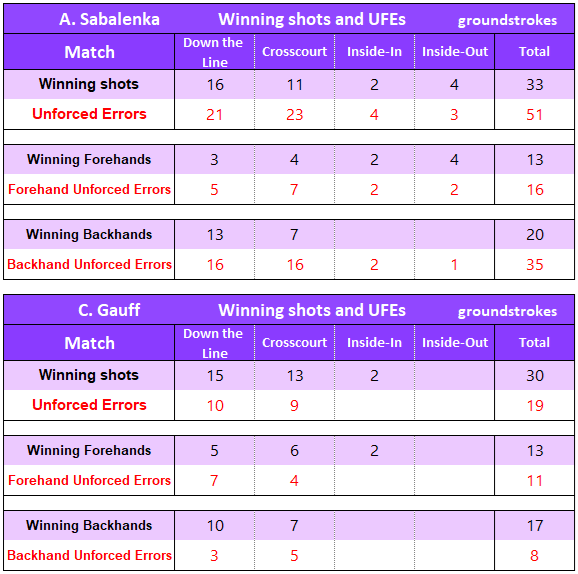
1st Serves
2nd Serves
Return & rallying performance
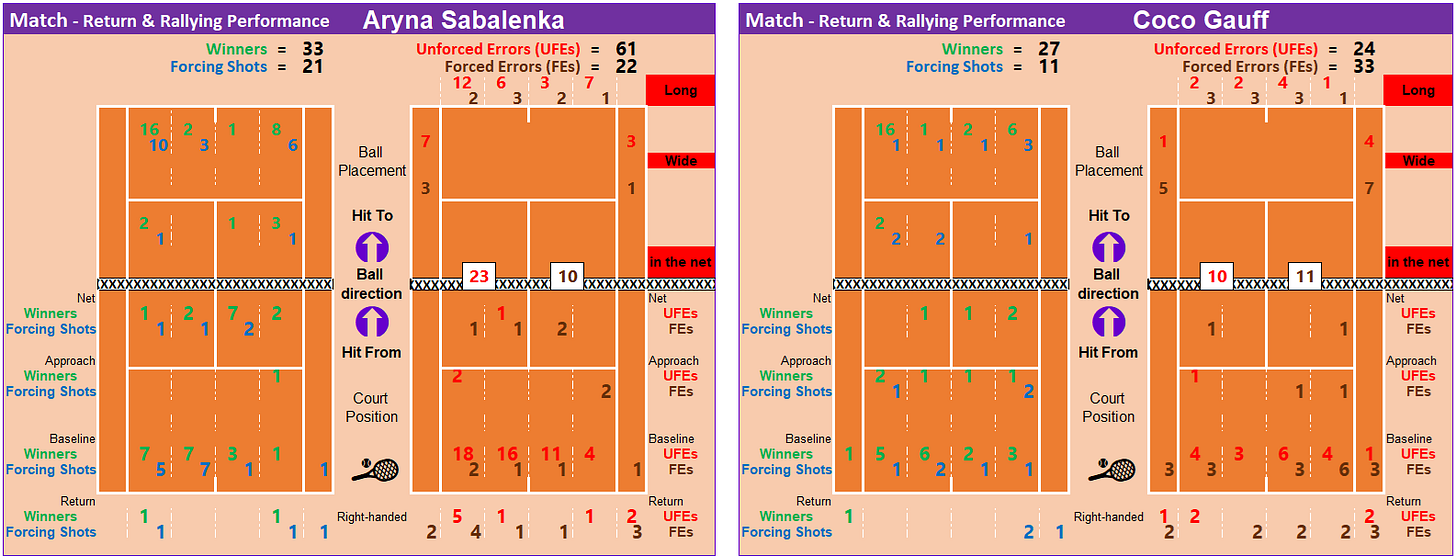
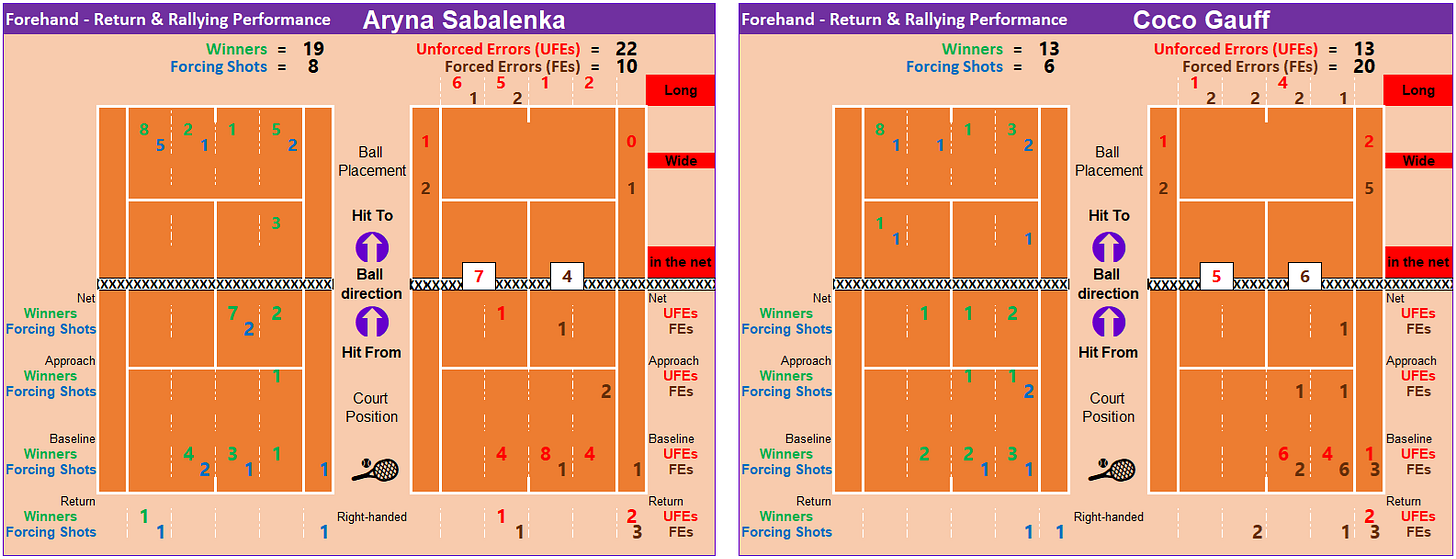
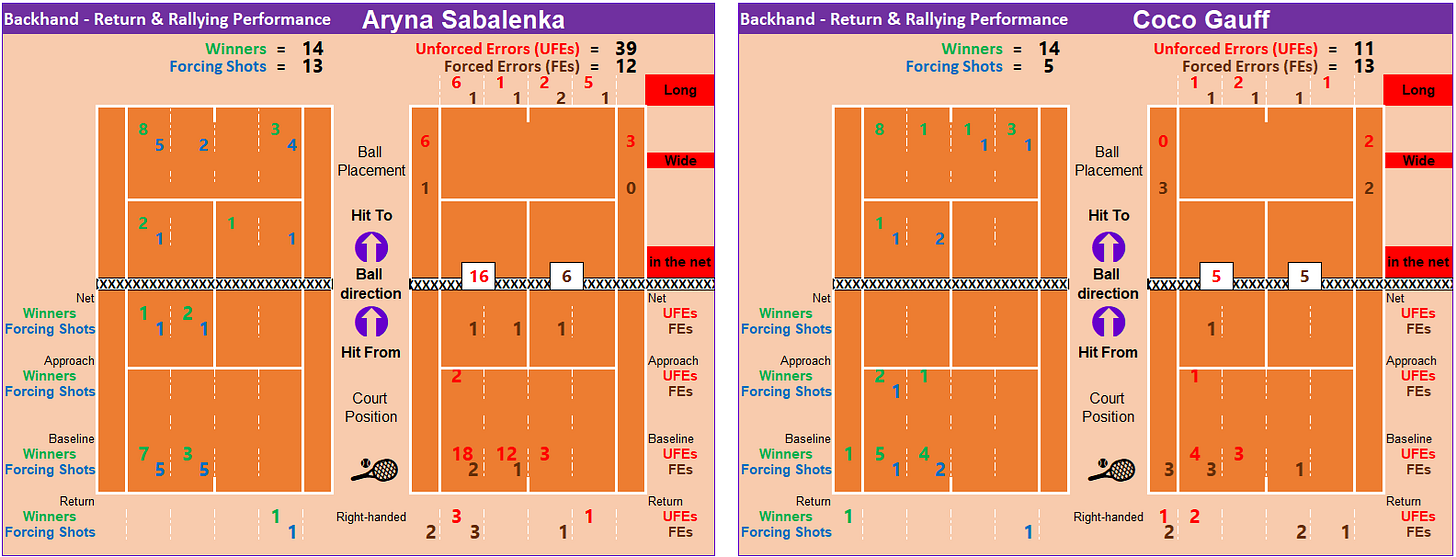
Rally Length
Points won breakdown
This final section gives a last, broader look at the match by presenting how each player won points. Points are listed according to their frequency (highest to lowest) and are named in relation to the last touch on the ball. For simplicity, groundstrokes hit from the 5th shot onwards are grouped together.
Breakdown by side (FHs or BHs)
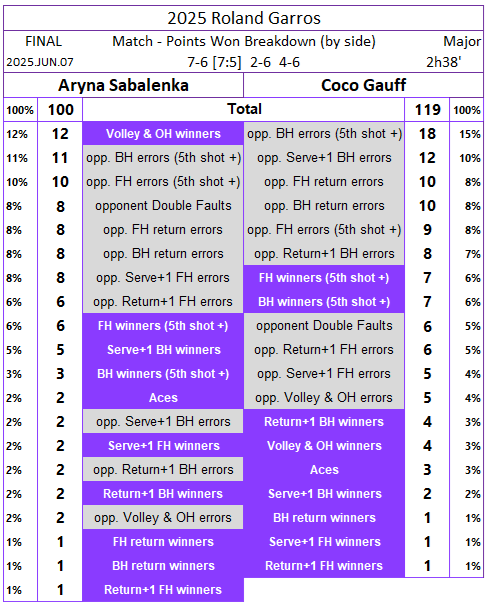
Breakdown by error type (UFEs or FEs)
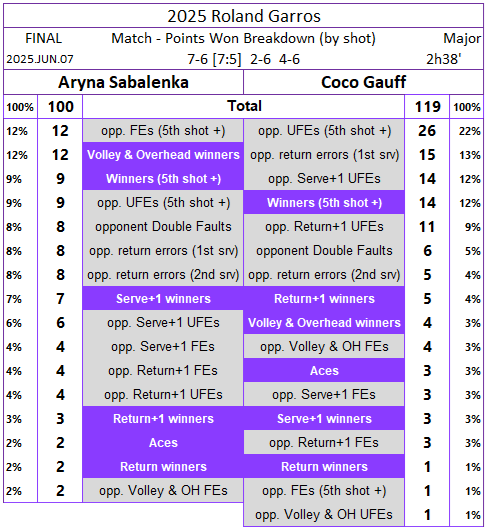
To find out more about the stats published here, please visit the following post.
While we follow the same criteria used on all major tennis events, our stats are collected through our own video analysis and are not official WTA or ITF stats.
Thanks for reading!
— Tennis Inside Numbers








